what is true about red buoys under the us aids to navigation system
Chapter 7: The Buoyage Arrangement
In 1983, Canada adopted the buoyage organization, or aids to navigation, used internationally. This organisation includes port manus buoys, starboard hand buoys, fundamental buoys and special buoys.
Aids to Navigation
Aids to navigation are devices (buoys) or systems (collision regulations), that are external to the pleasure craft. They are provided to help the operator of a pleasure craft decide position and course. They tin additionally warn the operator of dangers or obstructions and advise the operator of the location of the best or preferred route.
Port Hand and Starboard Manus Buoys
Port hand buoys are light-green and starboard paw buoys are red. They show which side of a channel is safest to travel; appropriately, they mark channels or hazards. Generally, green buoys must be passed on the left side of a arts and crafts heading upstream, i.e., against the current. Cherry buoys must exist kept on the right side of a craft when proceeding in the upstream direction. A uncomplicated rule is red to the right when returning, or the 3 "R's": scarlet, right, return.
In many places, the direction of the current is determined by consensus or by the tide. It is important to exist thoroughly familiar with the aids to navigation in your region.
Port Paw Buoys
Light-green in colour. They tin can be shaped as:
- cans
- spars
- pillars
If they do not have a dark-green light they will be apartment on top
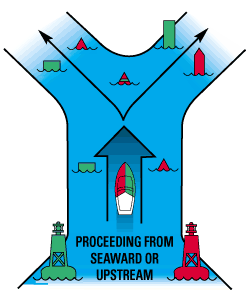
Starboard Paw Buoys
Red in colour. They can be shaped every bit:
- conical
- spars
- pillars
If they practice not have a cherry light they volition be conical on height.
Greenish port mitt buoys
- marks the port (left) side of a channel or the location of a danger and must be kept on the port (left) side of a pleasure craft when proceeding in the upstream direction;
- it is coloured green;
- displays identification letter(s) and odd number(s);
- if it carries a top mark, the top mark is a single green cylinder;
- if it carries a calorie-free, the light is green and is a flashing (FI) 4 s or quick flashing (Q) 1 s;
- if the buoy does non carry a lite, information technology has a flat meridian.
Red starboard hand buoys
- Marks the starboard (right) side of a channel or the location of a danger and must be kept on the starboard (right) side of a pleasure craft when proceeding in the upstream direction;
- is coloured ruby-red;
- displays identification letter(south) and even number(due south);
- if it carries a top mark, the top mark is a unmarried red cone, pointing upwards;
- if information technology carries a calorie-free, the light is cerise and is a flashing (F1) 4 s or quick flashing (Q) 1 southward;
- if the buoy does not carry a light, information technology has a pointed superlative.
Bifurcation buoys
- You lot may laissez passer buoys with crimson and green bands on either side in the upstream direction.
- The main or preferred aqueduct is shown by the color of the top ring.
- For instance, if a scarlet band is on top, you should continue the buoys on your starboard (right) side.
Know that a port hand solar day beacon is a beacon that
![]()
- marks the port (left) side of a channel or the location of a danger during daylight hours
- information technology must exist kept on the port (left) side of a pleasure craft when proceeding upstream;
- it is square with a black or dark-green coloured foursquare centered on a white background with a light-green reflecting border .. it may brandish an odd number fabricated of white reflecting material
Know that a starboard paw day beacon is a beacon that
![]()
- marks the starboard (right) side of a aqueduct or the location of a danger during daylight hours and must be kept on the starboard (right) side of a pleasure craft when proceeding upstream;
- it is a carmine coloured triangle centered on a white background with a red reflecting border; and may display an even number made of white reflecting material
Central Buoys
In that location are iv types of cardinal buoys: northward, south, westward and east. Cardinal buoys are used to signal the direction of the safest waters. A north key buoy indicates that the deepest or safest h2o exists to the due north of the buoy. The vessel must travel n past the north buoy; in this way, the buoy is betwixt the hazard and the arts and crafts. The same principles utilise to all of the central buoys. For more details on the hazard indicated past the buoy, a nautical chart must be consulted; the buoyage arrangement is therefore used in tandem with nautical charts.
There are two ways to distinguish among cardinal buoys: by colour and by the shape of their conical top marks. The management of the point indicates the type of primal buoy. Accordingly, the cones on a north fundamental buoy betoken northward, and on a south central beacon, betoken due south.
North Key Buoy
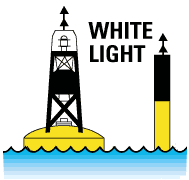
- A north cardinal buoy is located so that the safest water exists to the north of it
- It is coloured black and yellow
- The top one-half is painted black indicating that it is a n buoy...the lower half is painted xanthous
- If this buoy does not carry a light, it will exist spar shaped
- If information technology carries a tiptop mark...they will both point upwards to indicate north
South Cardinal Buoy
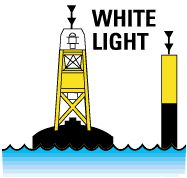
- A south cardinal buoy indicates that the safest water exists to the south of information technology.
- It is coloured black and yellow
- The black is positioned on the bottom indicating that it is pointing south...the upper portion is painted xanthous
- If this beacon does not carry a light, information technology will be spar shaped
- If it carries a top marking...they will both indicate downward to indicate due south
East Cardinal Buoy
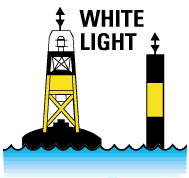
- An east key buoy is located to indicate that the safest water exists to the east of information technology
- It is coloured black and yellowish
- the blackness is positioned on the top and the bottom with the yellow portion in the middle to indicate that it is an east buoy
- If this buoy does not bear a light, it shall exist spar shaped
- If it carries a top marker...they will point in reverse directions to indicate that information technology is an eastward beacon
West Cardinal Beacon
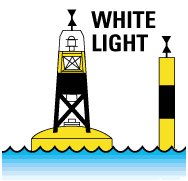
- A w fundamental buoy is located to bespeak that the safest h2o exists to the west of it.
- It is coloured blackness and yellow
- The black is positioned in the center to bespeak that it is a west beacon...the yellow is positioned meridian and bottom.
- If this beacon does not carry a low-cal, it shape be spar shaped
- If it carries a pinnacle marker...they will indicate in towards each other to indicate that information technology is a west buoy
As with any beacon...when encountered you should refer to your Nautical Charts for specific information.
Light Characteristics of Cardinal Buoys
The lights on all cardinal buoys volition exist white in color, (if the buoy is so equipped). In club to identify these buoys in darkness or reduced visibility, each one can be distinguished past different light flash characteristics.
The flash characteristics are based on the aforementioned numbering principle as an ordinary time clock.
The number of flashes coincides with the position of the face of the clock.
| North buoys wink at the rate of one per 2d or 60 per minute. A very quick flash can besides be used — ten flashes every 5 seconds. | ||
| Westward buoys flash at the rate of 9 times in 15 seconds. A very quick flash can also be used — ix flashes every 10 seconds. | 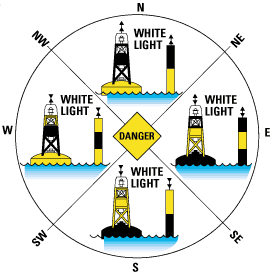 | East buoys flash at the charge per unit of 3 times every 10 seconds. A very quick flash can likewise be used — iii flashes every v seconds |
| Southward buoys flash at the rate of 6 times in 15 seconds followed by a single long wink. A very quick flash tin also exist used — half-dozen flashes every ten seconds plus ane longer wink at the finish of each group to mark the end of 1 wink cycle. |




Special Buoys
Finally, special buoys serve a variety of purposes. They are not primarily aids to navigation, only rather provide the boat operator with a host of data. Some are cautionary buoys to marking firing range or seaplane bases, while others gather atmospheric condition information, locate prohibited areas or marker designated mooring areas. The shape of the special buoys is not significant; they are identified by their symbols, drawings and colours.
Cautionary Buoy
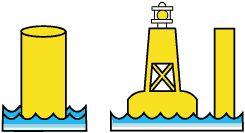
- they mark an area where mariners are to be warned of dangers such as firing ranges, racing courses, seaplane bases, underwater structures or areas where no prophylactic through channel exists and of traffic separations.
- they are coloured yellowish
- they brandish identification letters
- if information technology carries a top marking it shall be a single yellow 'Ten' shape
- if it carries a low-cal, the low-cal shall exist xanthous and flash once every 4 seconds
Anchorage Buoy
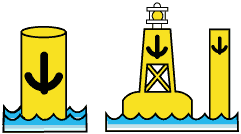
- information technology is used to indicate areas which are favourable
- for overnight anchoring • they are yellow in colour
- they ordinarily accept an anchor symbol clearly visible
- if it carries a lite the lite is yellow and it will wink in one case every four seconds.
Mooring Buoy

- used to moor or secure vessels
- it is the ONLY beacon that you may legally tie your vessel to
- usually institute in designated anchorage areas
- when in reduced visibility, be enlightened that other vessels may be nowadays and tied up
Control Buoy

- it is used to mark an area where boating is restricted
- it is coloured white
- it has an orange, open-faced circle on two contrary sides and 2 orangish horizontal bands, one above and one below the circle
- a black figure or symbol within the orange circle indicates the nature of the brake.
- if it carries a light is shall exist yellow and flash once every four seconds
Risk Buoy
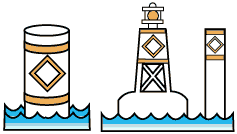
- information technology is a beacon which marks random hazards such equally rocks and shoals
- it is white in colour
- it has an orangish diamond on two reverse sides and two orangish horizontal bands, one above and one below the diamond symbols
- if information technology carries a light the lite is yellowish and flashes once every iv seconds
Information Buoy

- it displays data of interest to boaters. The message can either be displayed using lettering or symbols.
- it is white in colour
- it tin be distinguished by the orange open-faced square symbol on opposite sides and the 2 horizontal bands, i above and one below the square.
- if it carries a light information technology shall be yellow and information technology volition wink one time every 4 seconds
Swimming Buoy

- it is used to mark the perimeter of a swimming area
- it is white in colour
- if it carries a lite, the light is yellow and it will flash in one case every 4 seconds.
Diving Beacon

- it is used to mark an expanse where scuba or other such diving activity is in progress
- it is coloured white and it carries a scarlet flag not less than fifty centimetres square with a white diagonal stripe extending from the tip of the hoist to the bottom of the fly
- if it carries a low-cal the low-cal shall be yellow and wink in one case every iv seconds
Particular care must be taken when canoeing in waters where at that place are divers. A vessel engaged in diving must display a bluish and white flag (International Code A Flag, encounter left). A ruddy and white flag carried on a beacon is used to marker areas where diving is in progress, although divers may stray from the boundaries of the marked areas.
Exist certain you know what the 'diver down' flags look similar. If you lot come across either flag, proceed well articulate of the vessel and diving site, and move at slow speed.
Keep Out Buoy
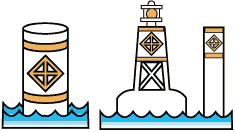
- A proceed out buoy marks an area in which boats are prohibited
- information technology is white in color
- it has an orangish diamond containing an orange cantankerous on ii reverse sides and 2 orange horizontal bands...one above and one beneath the diamond symbols
- if it carries a calorie-free the light is xanthous...flashing once every 4 seconds.
Scientific Buoys (O.D.A.Due south.)
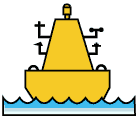
- An ocean data acquisition system buoy collects meteorological and other scientific information
Fairway Buoy
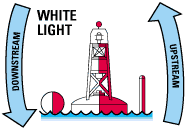
- usually institute at the entrances to channels or used to mark the center of a channel
- it may be passed on either side but should be kept on the port (left) side of your vessel when proceeding in either direction
Isolated Danger Buoy
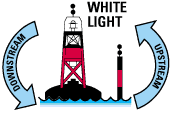
- it is used to mark an isolated hazard in waters which are otherwise navigable.
- it is usually moored directly on or to a higher place the danger
- it is used to mark a large rock, shoal or sunken ship
In addition to the to a higher place mentioned special buoys, you lot could as well encounter posted control signs or alert signs. These can be used to relay a host of information or provide warnings of impending danger. Some of these are:
- no wake zones
- no anchorage area signs
- speed limit zone signs
- low head dam hazard signs
- overhead or underwater electric line hazard signs
- pipe line hazards signs
It cannot be stressed plenty that every fourth dimension you encounter a sign or buoy you should reference your nautical charts to ensure that you lot correctly interpret the information.
The Nautical Chart
The Different Types of Chart
A simple visit to a map shop will quickly convince you lot of the vast range of products available. Outdoor enthusiasts tin discover topographical maps for mountain excursions, or guide maps to lakes and rivers to plan their canoe expeditions.
Naturally, travelers can plan their trips with a land, tourist or road map, and farmers can see the boundaries of their fields on a farm map. For boaters, the nautical chart is vital tool.
Main Features of a Nautical Chart
Nautical charts provide data on waterways. They give useful information to boaters, especially on water depth, the type of lesser, the type of shoreline, current management, coastal altitude, easily identifiable landmarks and aids to navigation.
The Canadian Hydrographic Service publishes all nautical charts. For pleasance craft, big calibration maps (i.e., covering a small portion of the region) are often the well-nigh useful because of all the detail they contain.
To know which regional chart is most appropriate for your activeness, consult the Nautical Nautical chart Catalogue. This catalogue is a large map showing the expanse covered by each available chart. For data on how to obtain charts, contact the Canadian Hydrographic Service.
Importance of the Nautical Chart to Boaters
Charts provide a host of information to boaters that only detailed knowledge and experience of the waterway could replace.
Using a nautical chart makes the boaters job in a rescue situation easier in many ways. Information technology:
- identifies a launch site
- shows the best route in light of currents, rapids, obstacles, etc.
- shows the location of waterway
- allows for an assessment of distances
- shows location on the water.
On receiving a distress call, the time may not seem correct to carefully study a chart. However, if the nautical chart is available, the noesis gained could mean the difference betwixt locating and successfully helping out at a water accident or a tragedy.
Topographical maps are maps of the land areas depicting natural and bogus features of the land, including elevation contours, shoreline, rocks, state features in a higher place water, and cultural features:
- They are intended primarily for the apply of the general public on the country;
- They are published by Natural Resources Canada and some provincial regime;
- 3 They are sometimes used when navigational maps (charts) are not available, but they usually exercise not depict: underwater hazards, marine aids to navigation, channels, anchorage areas etc.
Other Navigation Aids
A magnetic compass tin can be used to aid the operator of a pleasure craft find directions. Information technology must be remembered notwithstanding that a magnetic compass is influenced past the proximity of metallic and/or electric devices. In social club to avoid false information, make certain that the compass is mounted in an area free of magnetic and electrical interference.
Back to Top
Source: https://www.boaterexam.com/canada/education/c7-buoys-en.aspx
0 Response to "what is true about red buoys under the us aids to navigation system"
Postar um comentário